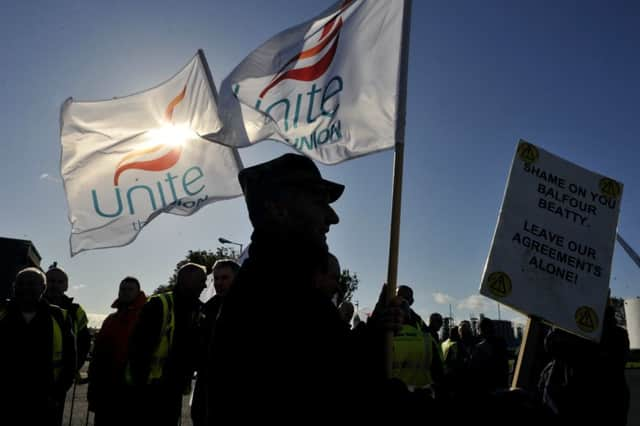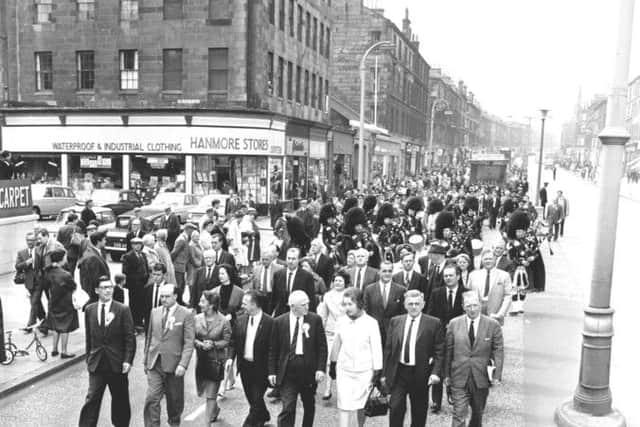In numbers: Trade union membership in Scotland


The number of workers in Scotland who are members of a trade union decreased by 79,000 between 1995 and 2014, according to the annual statistical bulletin produced by the UK Government.
But employees north of the border are still more likely to be union members than in England.
Advertisement
Hide AdAdvertisement
Hide AdAcross the UK, there were 6.4 million union members in 2014, broadly the same number as the year before. The peak total was 13.2 million in 1979, the year Margaret Thatcher’s first Conservative Government was elected.


There are around 600,000 affiliated members of the Scottish Trade Union Council (STUC), an umbrella organisation whose purpose is to “co-ordinate, develop and articulate the views and policies of the trade union movement in Scotland.”
When members of other independent professional unions not affiliated to the STUC, such as the Royal College of Nursing, are added to this total the number of union members is estimated to be around 700,000.
New legislation is currently being scrutinised at committee stage after a majority of MPs backed a new trade union bill in September. It would create minimum turnout thresholds for strike ballots and in public services requires at least 40 per cent of eligible union members to back a strike.
Business Secretary Sajid Javid said the government was not trying to ban or restrict strikes but to ensure ballots were fair and reasonable.
Dave Moxham, deputy general secretary of the STUC, said he was “bullish” that membership levels would stablise in Scotland and across the UK.
“There was a very steep fall in the 1980s and early 1990s,” he said. “Union membership has continued to drop but not at such a precipitous level. There are a number of reasons for that, but probably the main one was the enormous industrial change that took place - particularly the shift to the service sector where employment is very high turn over and very hard for the unions to get a foothold.
“What we find, among the top 50 companies, about half of those big private employers are unionised, including the big banks and manufacturers such as Rolls-Royce. We don’t see a reason for that to change. Not withstanding the trade union bill, we are quite bullish about stabilising membership levels.”
Advertisement
Hide AdAdvertisement
Hide AdMoxham said there continued to be pressing reasons for individuals to sign up as union members.
“There’s clear general evidence that where trade unions have high membership, and high levels of collective bargaining, overall income inequality is lower,” he said.
“Work places which have trade union recognition are likely to be pay up to £53 a week more per worker. This partly becaused some of the lowest paid sectors, such as hospitality, are not unionised.
“You’re also less likely, as a union member, to end up to up in an employment tribunal. This might seem counter-intutive to some people, but the statisitcs indicate that the majority of tribunals are undertaken from non-unionised workplaces - unions do a better job of fixing problems with employers before they get to that stage.”
Philip Taylor, professor of work and employment studies at Strathclyde Business School, said: “Trade union membership is often expressed as ‘density’ - the percentage of employees who are in a union. Density is far higher amongst public sector, at 53.2 per cent, than private sector workers at 14.2 per cent. It is slightly higher amongst women at 27.7 per cent, than men, at 22.3 per cent.
“Scotland’s density, at 30.4 per cent, is higher than that for the UK as a whole at 25 per cent, but not uniquely so as it is lower than that for Wales at 35.8 per cent.
Prof Taylor continued: “While the longer term decline in union membership has multiple causes, industrial restructuring, the decline of union strong sectors and the growth of service work are particularly important.
“Nevertheless, despite an overall decrease of 0.6 per cent in the past recordable year there has been a marginal increase in private sector union membership. On a more positive note for unions, as many as 44.3 per cent of all employees are in a workplace where a union is present.”